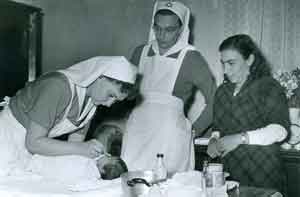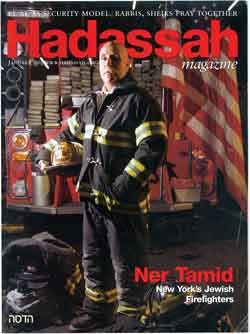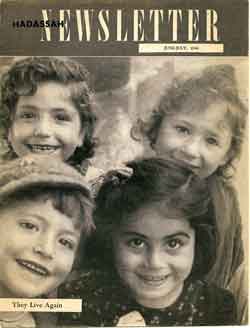Hadassah
Feature
Hadassah Magazine @ 100: An Odyssey from WWI to www

For much of 1917, Palestine was in limbo. Ottoman authorities had expelled non-Turkish citizens, including many Jewish residents and most foreign aid workers. Between America’s declaration of war in April and the British conquest of Jerusalem in December, Dr. Helena Kagan, a Swiss national, was virtually alone in dealing with public health in the city. She worked out of the Hadassah Policlinic and sent dispatches to New York—which were published in Hadassah Bulletin.
“Israel does not have a formal memorial to an unknown soldier,” wrote Mike Eskolsky in the January 1950 issue of Hadassah Newsletter, “but somewhere within its borders it now has an anonymous hero who is being made much of—an unknown millionth Jew.” Since Eskolsky could not identify the actual person—whether number one million had arrived “by Magic Carpet from Yemen, by sea to Haifa port or by stork to one of Hadassah’s hospitals”—he reported the news from the viewpoint of one Hannah Rivlin, who had been born in Jerusalem 100 years before and was still active, and described the Jewish population of Eretz Yisrael at various stages of her life.
Israel suffered more casualties in the Yom Kippur War than during any other conflict. The writer Chaim Potok was spending the year with his family in Jerusalem at the time and described, in the December 1973 edition of Hadassah Magazine, the scene as army officers arrived on his street to notify a neighbor of their son’s death; his daughter telling him of a classmate who lost her father; hospitals where visitors exchanged stories of who was injured and who had died; of how, in a small country, “everyone knows someone who fell.”

Shortly after 9/11, a New Yorker cover showed trick-or-treaters dressed as firefighters and policemen. Hadassah Magazine looked for unsung heroes who are always in our midst and found them in the Ner Tamid Society, the organization of New York City’s Jewish firefighters. Rahel Musleah told their story, in the January 2002 issue of Hadassah Magazine, focusing on men who had served for years and three who died in the attack on the World Trade Center. In her article, she mentioned that the daughter of one of the fallen Jewish firemen was just starting college. One reader of the article sent a donation for the young woman’s education.
These are random stories, revealing large currents and small facets of Jewish life and experience as they unfolded over the past century. It has been a momentous time, and Hadassah Magazine—which grew out of the original Hadassah Bulletin—has been around for all of it. With this edition, Hadassah Magazine is 100 years old. It has outlived Life, Look and many other venerable titles of American journalism. It has outlasted the original print editions of Newsweek and U.S. News & World Report. It is older than Time.
On the one hand, our survival should not be surprising. As the flagship publication of Hadassah, the Women’s Zionist Organization of America, we have a built-in readership—which has grown from 700 in 1914 to 330,000 today—that is passionate about Hadassah’s work, about Israel and about Jewish life. At the same time, the content of Hadassah Magazine has made for compelling reading: the development of the Zionist movement, two world wars, the founding of Israel and the Jewish state’s startling success in the face of long odds and intense hostility. The landscape on which Hadassah Magazine’s writers have operated has constituted the most eventful Jewish century, in terms of tragedy and triumph, of the past two millennia.
This magazine has reported on the challenges and successes of Hadassah over the years, from the first two Hadassah nurses dispatched to Jerusalem to the dedication of the Sarah Wetsman Davidson Hospital Tower in 2012, from the education of immigrant and at-risk youngsters at Hadassah’s Youth Aliyah Villages to Hadassah’s central role in American Jewish life and as a trailblazer of women’s leadership.

But even with the compelling articles our writers have produced, there are reasons to count Hadassah Magazine’s survival a surprise. Many publications that looked at the same horizon over the past century are gone. Many organizations—Jewish and otherwise—with dedicated members either did not develop a commitment to journalism beyond their own programs or failed to maintain that kind of commitment over time.
In contrast, Hadassah’s decision to nurture a publication that looked not only at the organization’s work but also the world in which that work took place has been constant. And it started with the first edition of Hadassah Bulletin, dated September 10, 1914, in which Gertrude Rosenblatt opened with a letter addressed, “Dear Sister Hadassahs.”
To be sure, the impetus of that first edition was to report to Hadassah members on the work of the organization, especially the mission of those first two nurses, Rachel Landy and Rose Kaplan, sent to Palestine the previous year. But Rosenblatt made clear to her readers that it would be impossible to report on the activities of Hadassah without including the larger context of world events.
“This month we have to call your attention to a happening of such grave import that it must find its place, not under the heading of information in the bulletin proper, but here in this letter, so that you may not fail to give it the attention its seriousness merits,” she wrote. “The European war has not left our movement unscathed. How could it have failed to leave its mark upon us when one-half of the Jewish race lives in the very regions that are the scenes of battle?”
She was referring, of course, to World War I, which had erupted six weeks earlier. The war that would cause so much death and destruction across Europe also changed—forever—the global Jewish landscape. It cut off migration routes and disrupted communication between leaders of the Zionist movement (which had its Executive Committee in Berlin). “Nine-tenths of the sources of income from which [the Zionist movement’s] institutions in Palestine have derived their support have ceased to flow since the Jews of Russia, Germany and Austria have been rendered incapable of continuing their communal activities,” Rosenblatt reported. “It [is] evident that we American Zionists, forming part of a neutral nation and part also of the second largest community in the world, must step in the breach.”
The war eventually spread to Palestine, affecting not only the Jewish community there but also Hadassah’s fledgling medical mission—as Dr. Kagan’s letters made clear. With the American Zionist movement taking on a much larger role in the campaign to build a Jewish state, and Hadassah’s early experience in medical mobilization, Hadassah Bulletin, later known as Hadassah Newsletter and eventually Hadassah Magazine, would have a story to tell that was inseparable from the larger currents of global affairs. And for 100 years, Hadassah’s story has been as integral to the development of Israel as Israel has been a focus of the world’s attention.
The magazine’s development has reflected changes in journalism and communications as well as a constant effort to report on Israel and Jewish life more deeply. In the 1950s, we began providing more coverage of Israel’s emerging culture and, in the 1960s, we started paying more attention to the Jewish renaissance in America. In the 1970s, we added more emphasis to Jewish life in other countries. In the 1980s, Hadassah Magazine received an endowment for the Harold U. Ribalow Prize—an annual award for fiction—at a time when fiction was a fading facet of mainstream American journalism.
For decades, many readers saw Hadassah Magazine as their main source of news on Israel and the Middle East. With the growth of Jewish journalism and the age of cable news and the Internet—and the 24-hour news cycle—we realized that a monthly publication needed to go beyond the headlines and into the nuances and the deeper corners of the news. And so we began reporting more on social and lifestyle issues, from Jewish parenting and genealogy to personalities, travel and gastronomy.
Just as our journalistic horizon has always included Hadassah and the wider world, so has our visibility. We have been heartened over the years not only by the dedication of loyal Hadassah readers, but also by recognition from the journalistic world. In 1993, Hadassah Magazine became the first Jewish publication ever nominated for a National Magazine Award. Over the past 30 years, we have received more Rockower Awards—given annually by the American Jewish Press Association—than all other magazines combined.
The birth of the Hadassah Magazine website in 2007 and its relaunch this year were logical steps in our 100-year effort to keep readers informed and to remain relevant—two goals that don’t always entirely overlap.
It’s hard to say how the magazine will fulfill its mission over the next century. During the past 20 years, the pace of change in communications has been much faster than it has been in philanthropy. But as long as there is a Hadassah there will be a need to tell its story and to link that story with the broader context of Jewish life and the well-being of Israel.










 Facebook
Facebook Instagram
Instagram Twitter
Twitter
Marni Anbar says
How can we see a copy of the first news bulletin. It would be a wonderful artifact to share with my daughter who is heavily into history, especially WW I and WW II. How valuable to be able to read about history from the standpoint of reading reports as it was happening.
Thank you.
Marni Anbar
Tempe, AZ
Leah Finkelshteyn says
The Hadassah Bulletins and Newsletters from 1914 to 1933 are available online. Search the digital collection of New York’s Center for Jewish History (http://digital.cjh.org).